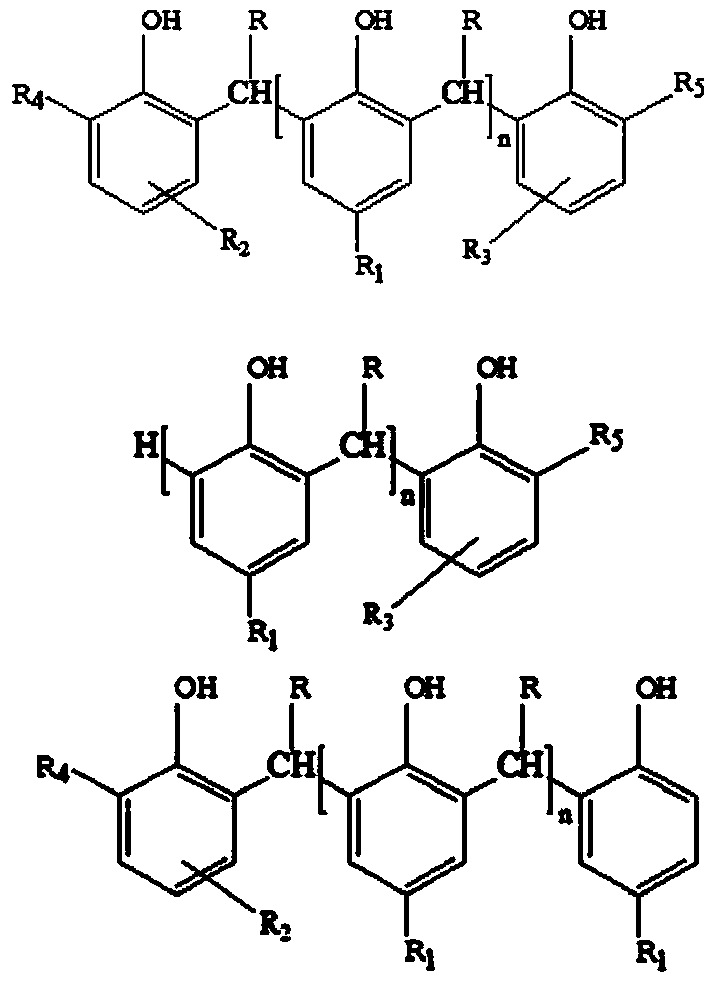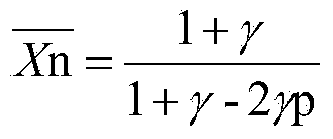Synthesis method of alkyl phenol aldehyde resin
A technology of alkylphenol formaldehyde resin and synthesis method, which is applied in the field of rubber manufacturing, can solve problems such as high equipment requirements, difficult realization, and environmental pollution, and achieve high monomer conversion rate, excellent viscosity increasing effect, and reduce environmental pollution.
- Summary
- Abstract
- Description
- Claims
- Application Information
AI Technical Summary
Problems solved by technology
Method used
Image
Examples
Embodiment 1
[0043] On the 1000ml four-neck reaction flask, install stirring, thermometer, reflux condenser and addition funnel. Put in 285g of p-tert-butylphenol, 20.6g of 2,4-di-tert-butylphenol, 1.0g of p-toluenesulfonic acid, 20g of solvent toluene, 110g of 37% formaldehyde solution, heat up to 100°C, and reflux for 2 hours . Atmospheric pressure was raised to 190°C for dehydration and toluene, and 0.7g of sodium hydroxide 20% aqueous solution was added to neutralize. The temperature was raised to 200°C and kept at this temperature for 2 hours. Drain the resin melt into a stainless steel pan and cool to room temperature. The product is orange, with a softening point of 126°C. The molecular weight of the resin is larger during dehydration, and the purpose of adding solvent toluene is to reduce the viscosity of the reaction system during dehydration.
Embodiment 2
[0045] On the 1000ml four-neck reaction flask, install stirring, thermometer, reflux condenser and addition funnel. Put in 255g of p-tert-butylphenol, 61.8g of 2,4-di-tert-butylphenol, 1.2g of p-toluenesulfonic acid, 90g of 37% formaldehyde solution, heat up to 100°C, and reflux for 2 hours. Atmospheric pressure is heated to 140°C for dehydration, and then 16g of aldehyde is added gradually, the temperature is raised to 190°C to remove residual water, and 0.8g of sodium hydroxide 20% aqueous solution is added for neutralization. The temperature was raised to 200°C and kept at this temperature for 2 hours. Drain the resin melt into a stainless steel pan and cool to room temperature. The product is orange, with a softening point of 127°C.
Embodiment 3
[0047] On the 1000ml four-neck reaction flask, install stirring, thermometer, reflux condenser and addition funnel. Put in 180g of p-tert-butylphenol, 164.8g of 2,4-di-tert-butylphenol, 1.2g of p-toluenesulfonic acid, 20g of solvent toluene, 120g of 37% formaldehyde solution, heat up to 100°C, and reflux for 2 hours . Atmospheric temperature is raised to 190°C for dehydration and toluene, and 0.8g of sodium hydroxide 20% aqueous solution is added for neutralization. The temperature was raised to 200°C and kept at this temperature for 2 hours. Drain the resin melt into a stainless steel pan and cool to room temperature. The product is orange, with a softening point of 125°C.
PUM
| Property | Measurement | Unit |
|---|---|---|
| Softening point | aaaaa | aaaaa |
| Softening point | aaaaa | aaaaa |
| Softening point | aaaaa | aaaaa |
Abstract
Description
Claims
Application Information
 Login to View More
Login to View More - R&D
- Intellectual Property
- Life Sciences
- Materials
- Tech Scout
- Unparalleled Data Quality
- Higher Quality Content
- 60% Fewer Hallucinations
Browse by: Latest US Patents, China's latest patents, Technical Efficacy Thesaurus, Application Domain, Technology Topic, Popular Technical Reports.
© 2025 PatSnap. All rights reserved.Legal|Privacy policy|Modern Slavery Act Transparency Statement|Sitemap|About US| Contact US: help@patsnap.com



